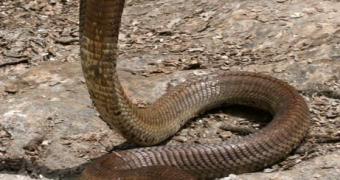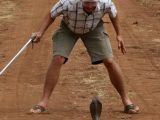Cobras are famous for their hood display, but some African species also because... they spit venom, like the black necked spitting cobra (Naja nigricollis) or ringed necked spitting cobras (Hemachatus hemachatus). They target the eyes and can spit with precision to a distance of 1.8 m (6 ft), but the venom can go even 4 m (13 ft) away. These cobras can launch up to 12 successive shots, at a pressure of 1.5 atmospheres, due to the instantaneous contraction of the muscles surrounding the venom glands.
The venom harms only if it touches the eyes, and if it is not rapidly removed, it can cause blindness.
Now, in Kenya, scientists have discovered a new giant species of spitting cobra, which at about 2.74 m (9 ft, 2 in) long it is the largest and the sixth spitting cobra encountered in Africa.
The large brown spitting cobra was previously believed to belong to the species of the black-necked spitting cobra, and was first found at a snake farm in June 2004, but only research made this year confirmed its status. The black-necked cobra grows no bigger than two m (6.6 ft).
The new species, baptized Naja ashei after James Ashe, founder of the Bio-Ken snake farm in Watamu, on the Kenyan coast, delivers 6.2 ml of liquid venom in one bite, among the largest venom quantities milked from a single snake, enough to kill 20 people. The new cobra inhabits the dry lowlands of northern and eastern Kenya, northeastern Uganda, southern Ethiopia and southern Somalia.
"But the most common area you can find this species is along the Kenyan coast," said herpetologist Royjan Taylor, who manages the Bio-Ken snake farm.
Morphological comparisons between the brown and black necked cobras showed that "differences are indeed a result of the population being different evolutionary lineages. The discovery appears to resolve the status of the eastern and northeastern Africa species, which was the remaining puzzle in the systematics of the African spitting cobras, which were lumped into a single species in the 20th century," said the authors, herpetologists Wolfgang Wuster and Donald G. Bradley.
Blood and tissue samples confirm that the massive, aggressive, extremely venomous snakes are a separate species. The new species feeds on much larger preys than other African species: these snakes have successfully swallowed a rabbit, a 75 cm (2.5 ft) long monitor lizard and 1.5 m (5 ft) long puff adder.
"Although the new species is not listed as endangered, conservation efforts must be increased since the reptile is threatened by human activities and encroachment. Although I am a naturalist and conservationist who is passionate about all wildlife, my heart goes out to the reptiles that are often misunderstood -- especially snakes. More research work needs to be done on their venom and its implication to snakebite treatment and anti-venom manufacture," said Taylor, whose contribution led to the new discovery.
"There have to be many other unreported species but hundreds are being lost as their habitats disappear under the continued mismanagement of our planet," said world-renowned conservationist Richard Leakey, who lives in Kenya.

 14 DAY TRIAL //
14 DAY TRIAL // 
